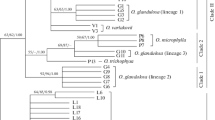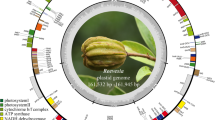Abstract
The DNA base compositions of 60 strains ofScenedesmus were determined and found to be a valuable indicator for the differentiation within this genus (except for the very closely related species of the subsect.Desmodesmus). The range for allScenedesmus species was 49.9–69.3 mol% GC for nuclear DNA and 36.8–39.9 mol% GC for chloroplast DNA. The separation of the genusTetradesmus cannot be verified by GC values, becauseS. obliquus andS. (“Tetradesmus”)wisconsinensis have a similar GC content.S. (“Chlorella”)ultrasquamata, S. costato-granulatus (sect.Costato-granulati) andS. lunatus are separated clearly from all other species of the genus because of their high GC content.
Similar content being viewed by others
References
Baharaeen, S., Bantle, J. A., Vishniac, S., 1982: The evolution of antarctic yeasts: DNA base composition and DNA-DNA homology. — Canad. J. Microbiol.28, 406–413.
Bellamy, A. R., Ralph, R. K., 1968: Recovery and purification of nucleic acids by means of cetyltrimethylammonium bromide. — InGrossmann, L., Moldave, K., (Eds.): Methods in Enzymology12 B, 156–160. — New York, London: Academic Press.
Charles, D., 1977: Isolation and characterization of DNA from unicellular algae. — Pl. Sci. Letters8, 35–44.
Chang, T. P., 1981: A comparative study ofPediastrum boryanum (Turp.)Menegh. andPediastrum duplex Meyen. — Arch. Protistenk.124, 232–243.
De Ley, J., 1969: Compositional nucleotide distribution and the theoretical prediction of homology in bacterial DNA. — J. Theoret. Biol.22, 89–116.
—, 1970: Reexamination of the association between melting point, buoyant density, and chemical base composition of desoxyribonucleic acid. — J. Bact.101, 738–754.
Green, B. R., 1974: Nucleic acids and their metabolism. — InStewart, W. D. P., (Ed.): Algal Physiology and Biochemistry, 281–313. — London: Blackwell Scientific Publs.
Hegewald, E., 1979: Vergleichende Beobachtungen an Herbarmaterial und Freilandmaterial vonScenedesmus. — Arch. Hydrobiol., Suppl.56, Algological Studies24, 264–286.
—, 1984: Hochtemperaturstämme in der GattungScenedesmus SektionDesmodesmus. — Arch. Hydrobiol. Suppl.67, Algological Studies37, 441–446.
-Schnepf, E., Paschma, R., 1987/8: Revision der Arten der UntersektionDesmodesmus der GattungScenedesmus. 1. Die Feinstrukturen der Zellwände und deren Variabilität. — (In preparation.)
Hellmann, V., Kessler, E., 1974a: Physiologische und biochemische Beiträge zur Taxonomie der GattungenAnkistrodesmus undScenedesmus. III. Die Basenzusammensetzung der DNS. — Arch. Microbiol.100, 239–242.
—, 1974b: Physiologische und biochemische Beiträge zur Taxonomie der GattungChlorella. VIII. Die Basenzusammensetzung der DNS. — Arch. Microbiol.95, 311–318.
Herdman, M., Janvier, M., Waterbury, J. B., Rippka, R., Stanier, R. Y., 1979: Deoxyribonucleic acid base composition of cyanobacteria. — J. Gen. Microbiol.111, 63–71.
Hortobagyi, T., 1960: Algen aus den Fischteichen von Buzsak II.Scenedesmus-Arten. — Nova HedwigiaI, 345–381.
—, 1967: Neue Beiträge zur Kenntnis der Scenedesmen Ungarns. — Acta Bot. Acad. Sci. Hung.13, 21–60.
—, 1970: Neue parallele Morphosen zwischenScenedesmus danubialis Hortob. n. sp. undS. spinosus Chod. — Acta Bot. Acad. Sci. Hung.16, 279–291.
Kessler, E., 1976: Comparative physiology, biochemistry, and the taxonomy ofChlorella (Chlorophyceae). — Pl. Syst. Evol.125, 129–138.
—, 1980: Physiological and biochemical contributions to the taxonomy of the generaAnkistrodesmus andScenedesmus. — Arch. Microbiol.126, 11–14.
—, 1984: A general review on the contribution of chemotaxonomy to the systematics of green algae. — InIrvine, D. E. G., John, D. M., (Eds.): Systematics of the Green Algae. — Systematics Association Special Vol. No.27, 391–407. — London, Orlando: Academic Press.
Lachance, M. A., 1981: Genetic relatedness of heterocystous cyanobacteria by deoxyribonucleic acid-deoxyribonucleic acid reassociation. — Int. J. Syst. Bact.31 c, 139–147.
Marmur, U., 1961: A procedure for the isolation of deoxyribonucleic acid from microorganisms. — J. Molec. Biol.3, 208–218.
Owen, R. J., Hill, G. R., 1979: The estimation of base compositions, base pairing and genome sizes of bacterial deoxyribonucleic acids. — InSkinner, F. A., Lovelock, D. W., (Eds.): Identification Methods for Microbiologists. — The Society for Applied Bacteriology, Technical Series14, 2. ed., 277–290. — London, New York, Toronto, Sydney, San Francisco: Academic Press.
Payer, H. D., Trültzsch, U., 1972: Ein Beitrag zur Versorgung dichter Kulturen von Grünalgen mit Mangan, Vanadium und anderen Spurenelementen. — Arch. Mikrobiol.84, 43–53.
Poncet, S., Fiol, J. B., Billon-Grand, G., 1984: Hybridation ADN-ADN chez quelques éspeces du genreHansenula. — Micropathologia86, 71–76.
Pryke, J. A., Cranney, K. M., Jones, D. S., 1979: Hybridization studies on DNA isolated fromScenedesmus obliquus. — Pl. Sci. Lett.16, 125–128.
Schildkraut, C. L., Marmur, J., Doty, P., 1962: Determination of the base composition of deoxyribonucleic acid from its buoyant density in CsCl. — J. Molec. Biol.4, 430–443.
Soeder, C. J., Schulze, G., Thiele, D., 1967: Einfluß verschiedener Kulturbedingungen auf das Wachstum in Synchronkulturen vonChlorella fusca Sh. etKr. — Arch. Hydrobiol., Suppl.2, 127–171.
Stam, W. T., Venema, G., 1977: The use of DNA-DNA hybridization for determination of the relationship between some blue-green algae (Cyanophyceae). — Acta Bot. Neerl.26, 327–342.
Stanier, R. Y., Kunisawa, R., Mandel, M., Cohen-Bazire, G., 1971: Purification and properties of unicellular blue-green algae (OrderChroococcales). — Bact. Rev.35, 171–205.
Stulp, B. K., Stam, W. T., 1984: Genotypic relationships between strains ofAnabaena (Cyanophyceae) and their correlation with morphological affinities. — Brit. Phycol. Bull.19, 287–301.
Trainor, F. R., 1966: A study of wall ornamentations in cultures ofScenedesmus. — Amer. J. Bot.53, 995–1000.
—,Cain, J. R., Shubert, L. E., 1976: Morphology and nutrition of the colonial green algaScenedesmus: 80 years later. — Bot. Rev. (Lancaster)42, 5–25.
Uherkovich, G., 1966: DieScenedesmus-Arten Ungarns. — Budapest: Akademiai kiado. 173 pp.
Author information
Authors and Affiliations
Rights and permissions
About this article
Cite this article
Paschma, R., Hegewald, E. DNA base composition within the genusScenedesmus (Chlorophyta). Pl Syst Evol 153, 171–180 (1986). https://doi.org/10.1007/BF00983685
Received:
Issue Date:
DOI: https://doi.org/10.1007/BF00983685




